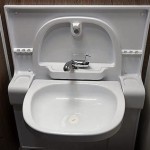Standard Height For Bathroom Sink Drain
Determining the correct height for a bathroom sink drain is crucial for both functionality and comfort. While seemingly a minor detail, the drain placement significantly impacts the usability of the sink, affecting everything from handwashing to teeth brushing. Understanding the standard measurements and the factors influencing optimal height ensures a practical and efficient bathroom design.
Understanding the Basics of Sink Drain Height
The standard height for a bathroom sink drain, measured from the finished floor to the center of the drain opening, typically falls between 29 and 31 inches. This range accommodates most users and aligns with standard plumbing practices. However, this isn't a rigid rule, and variations can occur based on specific sink styles, countertop thicknesses, and user needs.
Factors Influencing Optimal Drain Height
Several factors contribute to the ideal drain height for a particular bathroom. The height of the vanity cabinet plays a significant role, as a taller cabinet necessitates a higher drain placement. Similarly, the depth and design of the sink basin influence the optimal drain location. A deeper basin may require a slightly lower drain to prevent excessive splashing, while a shallow basin may benefit from a higher drain for efficient water flow.
The Role of Building Codes and Regulations
While a standard range exists, local building codes and regulations may dictate specific requirements for sink drain height. Compliance with these codes is essential for ensuring safety and functionality. Consulting local plumbing codes before installation confirms adherence to regulations and avoids potential issues.
Variations for Different Sink Types
The type of sink installed also influences the appropriate drain height. Vessel sinks, which sit atop the countertop, typically require a higher drain placement to accommodate the added height of the basin. Undermount sinks, installed beneath the countertop, often utilize a standard drain height. Wall-mounted sinks, with no vanity cabinet, offer greater flexibility in drain placement, allowing for customization based on user preference and accessibility requirements.
Considerations for Accessibility and Universal Design
Incorporating accessibility principles into bathroom design is crucial for creating a usable space for individuals with disabilities. For wheelchair users, a lower sink height and drain placement are essential for comfortable access. Universal design principles, which prioritize usability for people of all ages and abilities, often recommend a slightly lower sink and drain height than the standard range.
Impact on Functionality and User Experience
The correct drain height directly impacts the functionality and user experience of the bathroom sink. A drain placed too high can result in awkward postures and difficulty reaching the faucet. Conversely, a drain placed too low can cause back strain and discomfort. Finding the optimal balance ensures comfortable and efficient use for all individuals.
Working with Professionals for Installation
While understanding the standard measurements is helpful, consulting with qualified plumbing professionals is essential during the installation process. Experienced plumbers possess the expertise to assess the specific requirements of the bathroom and ensure proper drain placement. They can also advise on any necessary adjustments based on the chosen sink, vanity, and user needs, ensuring optimal functionality and compliance with building codes.
Measuring and Marking for Accurate Placement
Accurate measurement and marking are crucial for achieving the correct drain height. Prior to installation, carefully measure the distance from the finished floor to the desired drain center. Mark this point clearly on the wall or vanity cabinet to guide the installation process. Double-checking measurements ensures precision and avoids costly adjustments later.
Addressing Common Issues with Drain Height
Occasionally, issues may arise with drain height after installation. If the drain is too high or too low, adjustments may be necessary. In some cases, adjusting the p-trap or drainpipe can resolve the issue. For more significant discrepancies, replacing the sink or vanity may be required. Addressing these issues promptly ensures optimal functionality and prevents further complications.

Standard Vanity Height With Vessel Bathroom Sink Drain Kitchen Countertop Faucets

19 5 Lacava Tre Vanity Top Or Wall Mount Sink 2982 Bathroom Vanities And More

Bathroom And Restroom Measurements Standards Guide

How To Plumb A Bathroom With Multiple Plumbing Diagrams Hammerpedia

What Is The Standard Bathroom Sink Height Vanity Sizes Drain Counter Top

Sink Height From The Floor Considerations Showergroom

How To Fit A Bathroom Sink Diy Guides Victorian Plumbing

Bathroom Vanities Buy Vanity Furniture Cabinets Rgm Distribution

Pin On Diagram

Quick Guide To Bathroom Sink Plumbing Rough In Heights Phyxter Home Services
Related Posts







